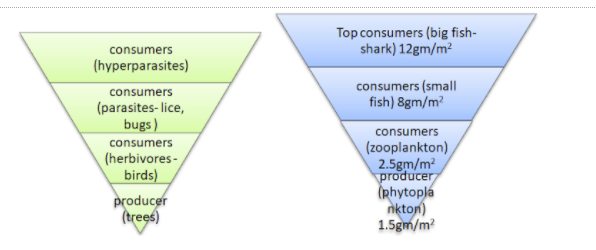
An inverted pyramid of number and an inverted pyramid of biomass are respectively seen in:
(a) Grassland and tree ecosystem
(b) Sea and Tree ecosystem
(c) Tree and Sea ecosystem
(d) Sea and Grassland ecosystem
(e) Tree and Grassland ecosystem
Answer
582k+ views
Hint: Pyramid of numbers shows the number of individual organisms at different trophic levels of the ecosystem. The pyramid of biomass shows the total dry weight and another suitable measure of the total amount of living matter at each level.
Complete answer:
The pyramid of number and biomass can either be upright or inverted or dumbbell-shaped, this depends on the nature of the food chain. Let’s see the pyramid of numbers for trees: we have at the base level producers which are trees that produce their food by a process called photosynthesis. Then comes herbivores which include birds, this is first-order consumers. Then comes parasites which include insects like lice, even though small in size they are greater in number. Lastly, we have the hyperparasites which are parasites and its host is also a parasite.
We can see that as we go from producers to top consumers it increases, and thus the pyramid is said to be inverted. But the pyramid of biomass is upright for the tree ecosystem.
In the aquatic ecosystem, the biomass of consumers is always greater than the biomass of producers hence it occurs as an inverted pyramid. The producers which are mainly the phytoplankton such as algae, bacteria, etc. are at the base. Then comes first-order consumers such as zooplankton (also this level includes certain fish), then the small fish, then larger fish such as sharks (carnivores). But the pyramid of numbers in the aquatic ecosystem is upright.
Given below is the pyramid of numbers for trees and the pyramid of biomass for the sea.

Let’s see the other option; Grassland ecosystem: The pyramid of biomass is upright, the pyramid of biomass shows a gradual reduction in biomass at each trophic level. The pyramid of numbers is also upright. The food chain looks like:
So, the correct answer is 'tree and sea ecosystem'.
Note: The pyramid is designed to show the relationship between different organisms is known as an ecological pyramid. A pyramid of number and pyramid of biomass comes under the classification of ecological pyramids. A graphical representation of each of the bars that make up the pyramid represents a different trophic level. Ecological pyramids are generally of three types: the pyramid of number, pyramid of biomass, and pyramid of energy (showing the rate of energy flow).
Complete answer:
The pyramid of number and biomass can either be upright or inverted or dumbbell-shaped, this depends on the nature of the food chain. Let’s see the pyramid of numbers for trees: we have at the base level producers which are trees that produce their food by a process called photosynthesis. Then comes herbivores which include birds, this is first-order consumers. Then comes parasites which include insects like lice, even though small in size they are greater in number. Lastly, we have the hyperparasites which are parasites and its host is also a parasite.
We can see that as we go from producers to top consumers it increases, and thus the pyramid is said to be inverted. But the pyramid of biomass is upright for the tree ecosystem.
In the aquatic ecosystem, the biomass of consumers is always greater than the biomass of producers hence it occurs as an inverted pyramid. The producers which are mainly the phytoplankton such as algae, bacteria, etc. are at the base. Then comes first-order consumers such as zooplankton (also this level includes certain fish), then the small fish, then larger fish such as sharks (carnivores). But the pyramid of numbers in the aquatic ecosystem is upright.
Given below is the pyramid of numbers for trees and the pyramid of biomass for the sea.

Let’s see the other option; Grassland ecosystem: The pyramid of biomass is upright, the pyramid of biomass shows a gradual reduction in biomass at each trophic level. The pyramid of numbers is also upright. The food chain looks like:
So, the correct answer is 'tree and sea ecosystem'.
Note: The pyramid is designed to show the relationship between different organisms is known as an ecological pyramid. A pyramid of number and pyramid of biomass comes under the classification of ecological pyramids. A graphical representation of each of the bars that make up the pyramid represents a different trophic level. Ecological pyramids are generally of three types: the pyramid of number, pyramid of biomass, and pyramid of energy (showing the rate of energy flow).
Recently Updated Pages
Master Class 11 Economics: Engaging Questions & Answers for Success

Master Class 11 English: Engaging Questions & Answers for Success

Master Class 11 Social Science: Engaging Questions & Answers for Success

Master Class 11 Biology: Engaging Questions & Answers for Success

Class 11 Question and Answer - Your Ultimate Solutions Guide

Master Class 11 Business Studies: Engaging Questions & Answers for Success

Trending doubts
10 examples of friction in our daily life

One Metric ton is equal to kg A 10000 B 1000 C 100 class 11 physics CBSE

Difference Between Prokaryotic Cells and Eukaryotic Cells

1 Quintal is equal to a 110 kg b 10 kg c 100kg d 1000 class 11 physics CBSE

State the laws of reflection of light

Explain zero factorial class 11 maths CBSE




